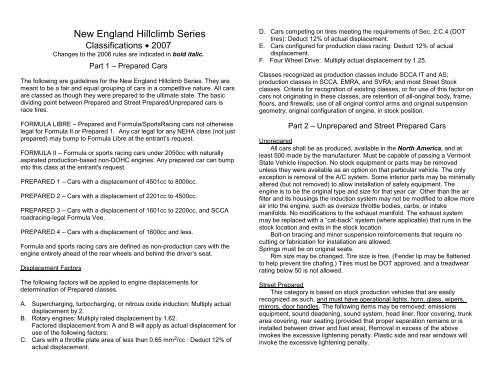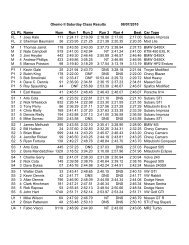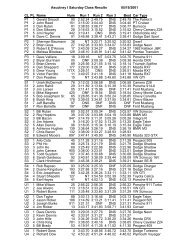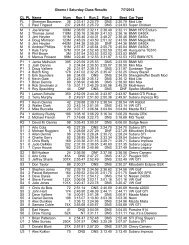Classification - New England Hillclimb Association
Classification - New England Hillclimb Association
Classification - New England Hillclimb Association
Create successful ePaper yourself
Turn your PDF publications into a flip-book with our unique Google optimized e-Paper software.
<strong>New</strong> <strong>England</strong> <strong>Hillclimb</strong> Series<br />
<strong>Classification</strong>s • 2007<br />
Changes to the 2006 rules are indicated in bold italic.<br />
Part 1 – Prepared Cars<br />
The following are guidelines for the <strong>New</strong> <strong>England</strong> <strong>Hillclimb</strong> Series. They are<br />
meant to be a fair and equal grouping of cars in a competitive nature. All cars<br />
are classed as though they were prepared to the ultimate state. The basic<br />
dividing point between Prepared and Street Prepared/Unprepared cars is<br />
race tires.<br />
FORMULA LIBRE – Prepared and Formula/SportsRacing cars not otherwise<br />
legal for Formula II or Prepared 1. Any car legal for any NEHA class (not just<br />
prepared) may bump to Formula Libre at the entrant’s request.<br />
FORMULA II – Formula or sports racing cars under 2050cc with naturally<br />
aspirated production-based non-DOHC engines. Any prepared car can bump<br />
into this class at the entrant's request.<br />
PREPARED 1 – Cars with a displacement of 4501cc to 8000cc.<br />
PREPARED 2 – Cars with a displacement of 2201cc to 4500cc.<br />
PREPARED 3 – Cars with a displacement of 1601cc to 2200cc, and SCCA<br />
roadracing-legal Formula Vee.<br />
PREPARED 4 – Cars with a displacement of 1600cc and less.<br />
Formula and sports racing cars are defined as non-production cars with the<br />
engine entirely ahead of the rear wheels and behind the driver’s seat.<br />
Displacement Factors<br />
The following factors will be applied to engine displacements for<br />
determination of Prepared classes.<br />
A. Supercharging, turbocharging, or nitrous oxide induction: Multiply actual<br />
displacement by 2.<br />
B. Rotary engines: Multiply rated displacement by 1.62.<br />
Factored displacement from A and B will apply as actual displacement for<br />
use of the following factors:<br />
C. Cars with a throttle plate area of less than 0.65 mm 2 /cc : Deduct 12% of<br />
actual displacement.<br />
D. Cars competing on tires meeting the requirements of Sec. 2.C.4 (DOT<br />
tires): Deduct 12% of actual displacement.<br />
E. Cars configured for production class racing: Deduct 12% of actual<br />
displacement.<br />
F. Four Wheel Drive: Multiply actual displacement by 1.25.<br />
Classes recognized as production classes include SCCA IT and AS;<br />
production classes in SCCA, EMRA, and SVRA; and most Street Stock<br />
classes. Criteria for recognition of existing classes, or for use of this factor on<br />
cars not originating in these classes, are retention of all-original body, frame,<br />
floors, and firewalls; use of all original control arms and original suspension<br />
geometry; original configuration of engine, in stock position.<br />
Part 2 – Unprepared and Street Prepared Cars<br />
Unprepared<br />
All cars shall be as produced, available in the North America, and at<br />
least 500 made by the manufacturer. Must be capable of passing a Vermont<br />
State Vehicle Inspection. No stock equipment or parts may be removed<br />
unless they were available as an option on that particular vehicle. The only<br />
exception is removal of the A/C system. Some interior parts may be minimally<br />
altered (but not removed) to allow installation of safety equipment. The<br />
engine is to be the original type and size for that year car. Other than the air<br />
filter and its housings the induction system may not be modified to allow more<br />
air into the engine, such as oversize throttle bodies, carbs, or intake<br />
manifolds. No modifications to the exhaust manifold. The exhaust system<br />
may be replaced with a “cat-back” system (where applicable) that runs in the<br />
stock location and exits in the stock location.<br />
Bolt-on bracing and minor suspension reinforcements that require no<br />
cutting or fabrication for installation are allowed.<br />
Springs must be on original seats.<br />
Rim size may be changed. Tire size is free. (Fender lip may be flattened<br />
to help prevent tire chafing.) Tires must be DOT approved, and a treadwear<br />
rating below 50 is not allowed.<br />
Street Prepared<br />
This category is based on stock production vehicles that are easily<br />
recognized as such, and must have operational lights, horn, glass, wipers,<br />
mirrors, door handles. The following items may be removed: emissions<br />
equipment, sound deadening, sound system, head liner, floor covering, trunk<br />
area covering, rear seating (provided that proper separation remains or is<br />
installed between driver and fuel area). Removal in excess of the above<br />
invokes the excessive lightening penalty. Plastic side and rear windows will<br />
invoke the excessive lightening penalty.
Relocation of accessories, batteries, fuel system, electrical components<br />
is allowed, provided that the exterior of vehicle remains as produced.<br />
Interchange of production options within the model is free (while adhering<br />
to the adjustments from the norm section). Engine/ driveline modifications<br />
are allowed.<br />
Rim size may be changed. Tire size is free but the tread may not be seen<br />
from above. Tires must be DOT approved. Wheel openings shall retain their<br />
original contour when viewed from the side.<br />
The above paragraphs do not void any applicable safety requirements as<br />
listed in the Technical and Safety Requirements.<br />
Class Determination<br />
Classes are determined within a category by the ratio of adjusted engine<br />
displacement (in cubic centimeters) to vehicle weight (in pounds).<br />
Curb weights are those published in the N.A.D.A. used car dealer guide,<br />
if available, or on the vehicle manufacturer’s tag if equipped and not<br />
tampered with. If the tag weight is used, it will be given in gross vehicle weight<br />
and must be adjusted. Subtract 175 lb per occupant, from the GVW to get<br />
curb weight.<br />
Actual displacement is adjusted by factors from the “norm” and then<br />
divided by the curb weight. (Norm = 2 valves and 1 injector per cylinder<br />
normally aspirated, in-line configuration.) This number will be used to class<br />
the car. Note: Rotary displacement is doubled prior to applying factors.<br />
The tech inspectors are empowered to inspect your vehicle and personal<br />
equipment for general safety for participation at our events. Tech inspectors<br />
are NOT the classification committee.<br />
There are 8 classes based on modifications and adjusted cc/lb:<br />
UNPREPARED CLASSES<br />
Unprepared 1 1.550 and above cc/lb<br />
Unprepared 2 Less than 1.550 cc/lb<br />
Unprepared 3 Less than 1.000 cc/lb<br />
Unprepared 4 Less than 0.840 cc/lb<br />
STREET PREPARED CLASSES<br />
Street Prep 1 1.500 and above cc/lb<br />
Street Prep 2 Less than 1.500 cc/lb<br />
Street Prep 3 Less than 1.060 cc/lb<br />
Street Prep 4 Less than .900 cc/lb<br />
car’s weight to come up with your class factor. Apply this number to the chart<br />
above. Then come run and have fun!<br />
In addition:<br />
• There will be no penalty for a roll cage regardless of how it is tied in to the<br />
body structure, or for racing seats.<br />
• Updating or backdating within the model will not be penalized (factors will<br />
be assessed after the changes).<br />
• Emission requirements shall not be considered in the enforcement of<br />
these rules.<br />
• No kit cars and no engine swaps will be allowed in Unprepared. In Street<br />
Prepared and Prepared, kit cars and engine swaps will be classed where<br />
deemed most competitive.<br />
Adjustments to the displacement for variations from the norm will be:<br />
Variable valve timing 25%<br />
Four-wheel drive 25%<br />
Wheel size (diameter and width) 1% per 0.5 inch<br />
Tire treadwear rating (50–150 U Class) (< 100 SP Class) 8%<br />
Non-stock antiroll bars (SP only) 5%<br />
Non-stock springs (SP only) 5%<br />
Modified suspension (SP only) 5%<br />
(other than shocks, alignment, and bolt-on reinforcement)<br />
6-point roll cage (U Class ) – 5%<br />
6-point roll cage (SP Class ) – 20%<br />
Intact interior (SP only with full cage) – 5%<br />
Excessive lightening (SP only) 10%<br />
More than 2 valves per cylinder * 10% each<br />
More than 1 camshaft per bank of cylinders 5%<br />
V type engine configuration 10%<br />
1 venturi or injector per 4 or more cylinders – 20%<br />
1 venturi or injector per 2 cylinders – 10%<br />
Non-stock exhaust manifold (SP only) 10%<br />
Non-stock induction (SP only) 10%<br />
Turbocharger 30%<br />
Supercharger 25%<br />
Intercooler 25%<br />
Excessive sound (over 96 dB) at 50 feet 15%<br />
Nitrous oxide (mandatory fire system) (SP only)<br />
+ 1 Class<br />
* Stratified charge valves not included.<br />
To determine your car’s class, multiply your car’s displacement by each<br />
applicable adjustment on the next page. Take the sum and divide this by the





